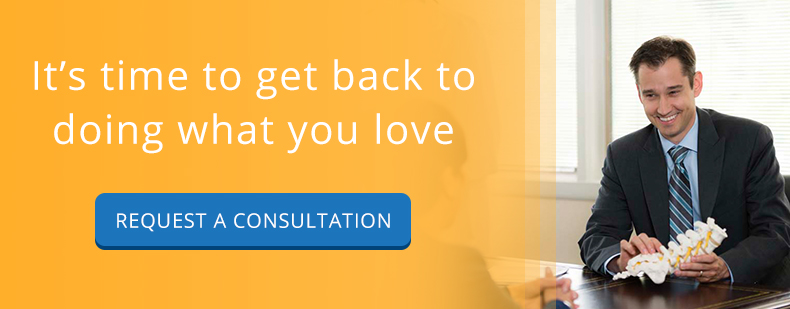Have you reached the point of needing back surgery for a herniated disk? Surgery may be the next step in your recovery from herniated disk symptoms when no other treatment has helped.
What is a herniated disk?
Your spine is comprised of a total of 33 individual bones. These bones are each hollow in the center, creating a space for your spinal cord and nerves to travel from your brain to your body. Each of these bones is also uniquely shaped, allowing them to stack together in an interlocking pattern.
To keep these bones from rubbing and wearing on one another (and pinching your nerves and spinal cord) and to allow movement of your spine, there is a rubbery disk of tissue between each one. These are known as intervertebral disks.
The intervertebral disk acts as a cushion for each of the spinal bones and helps protect the spinal cord as it travels between each of the vertebrae. It has a tough, fibrous outer layer. Within is a gel-like substance that provides the majority of the impact-relieving support.
When the outer layer of a disk is injured the “gel” can be pushed out into the spinal canal, putting pressure on your spinal cord and nerves, causing unpleasant symptoms and the eventual need to seek back surgery for a herniated disk.
A herniated disk can occur due to a number of reasons, including normal wear and tear from aging (the disks can actually “dry out” as you age), trauma or extreme strain being placed on the disk. Some conditions can also predispose you to develop a ruptured disk.
The symptoms of a herniated disk
Your spine is divided into five regions.
- Cervical (topmost area, sitting right beneath your skull and through your neck)
- Thoracic (from about the level of your shoulders down to the bottom of your ribs)
- Lumbar (your lower back, to right below your waist)
- Sacrum (the next 5 vertebrae)
- Coccyx (your tailbone)
A herniated disk is most likely to occur in the cervical or lumbar regions of your spine.
Herniated disk symptoms run the gamut from asymptomatic (no signs or symptoms) to mild to severe and debilitating. Regardless of where you are in the progression of your herniated disk, if the treatments you are receiving aren’t working, it’s time to consider a surgical approach.
Common cervical herniated disk symptoms
The cervical region of your spine is the second most common area of the spine to develop a herniated disk. The symptoms associated with a cervical herniated disc develop from compression of either an individual nerve root or the spinal cord and include:
- Pain or tingling in the neck and possibly down into the shoulders, arms and even hands and fingers
- Numbness and weakness in the aforementioned areas
- More extreme cases can experience a loss of fine motor skills in the hands and fingers, difficulty walking, or a sensation of heaviness and immobility in the legs
- Bowel or bladder control problems
Thoracic herniated disk symptoms
Thoracic herniated disks are the least common type of disk herniations but do still occur. The symptoms of a thoracic hernia can include:
- Pain that will travel around on either one or both sides of the rib cage from the back into the chest or abdomen.
- Muscle weakness in one or both legs
- Numbness and tingling in one or both legs
- Overactive reflexes causing spastic responses in one or both legs
- Bowel or bladder control problems
Common lumbar herniated disk symptoms
Lower back pain is an incredibly common complaint. In some cases, it may be due to a herniated lumbar disk. As with the other two areas of your spine, the symptoms can vary a bit from those that accompany hernias in other spinal regions. These symptoms can include:
- Pain in one or both or your legs or feet
- Muscle weakness in the legs
- Numbness, tingling or burning in the legs
- Balance or gait difficulty
- Bowel or bladder compromise or incontinence
Treatment options for a herniated disk
There are a few treatments that can be used for herniated disks. Typically, your doctor will opt to take the conservative route first and recommend these treatments to you.
Pain medications and NSAIDs (non-steroidal anti-inflammatory drugs) might be the first course of action your doctor recommends. These can be either over-the-counter or prescription. While they may provide temporary relief, in severe cases they may just mask symptoms or, not even begin to touch the pain and discomfort.
Injections of corticosteroids are also used at the site of the ruptured disk to help decrease inflammation. Again, this is a temporary option and if the disk rupture doesn’t resolve during their use, spine surgery for a herniated disk may be warranted.
Physical therapy may also be recommended prior to opting for surgery. This can help strengthen the muscles and stretch ligaments in your back, aiding in flexibility and decreasing pressure on the affected area(s) of your spine.
If none of the above work, spine surgery for a herniated disk is likely your next step.
Your spine surgery may be as simple as a partial discectomy (removing only part of the disk), or as involved as removing the damaged disk and replacing with a prosthetic disk.
Depending on the severity of your spinal disk herniation, you may also require a concurrent procedure known as a fusion. This procedure involves joining the adjacent vertebrae to create a more solid, column-like structure, preventing movement between the two vertebrae surrounding the disk.
You and your doctor will be the best judges of when it is the right time to seek surgical intervention for your ruptured disk. There is a finite number of nonsurgical treatment options and discussing them with your doctor should give you the confidence to know next steps are required.


